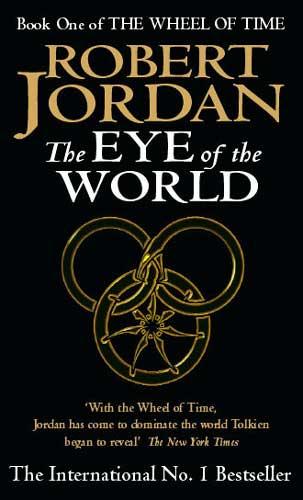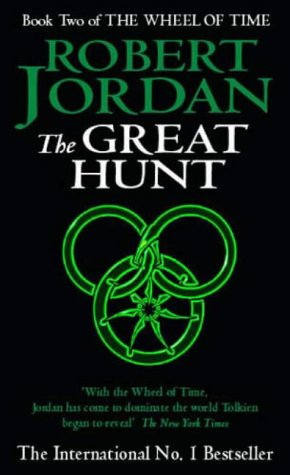



So, back when we still had double English in the seven-day cycle, we used to have library periods. Within one particular session holed up behind the bookshelves in an armchair, I ran into my English teacher, who literally thrust this book into my hands and told me she thought I would enjoy it. At the time, it looked massive, and it turned out it really was massive, but I am not one to shy from large books; I'll read anything that has print. So I took it home. Mrs Harris, I owe you.
Trying to encapsulate one of my true fandoms in a blog post is like attempting to pack for an overseas trip when you only own one small suitcase; you eventually come to the conclusion that ninety percent of what is important won't fit, and just end up bringing the bare essentials. Even the bare essentials will make this post far longer than any other- and I'm still only halfway through the series. The world of the Wheel of Time is an incredibly complex, well-developed, intricate fictional world spanning fourteen books, each of which is about eight hundred to a thousand pages in tiny print; there are inconsistencies, naturally, but on the whole it's one of the best-developed fantasy worlds I've ever seen. It sounds perfectly like yet another cliche magic series from the blurbs- those blurbs never do the books that they're supposed to summarize justice, do they?- but I was surprised by the maturity of the prose and the plots and how convincing the character development was, particularly that of the protagonists. Honestly, you English teachers- if you want a brilliant character arc to teach with, have everyone read Wheel of Time. It might take a little while for everyone to finish reading, sure, but you can't beat Rand's wrenching, uncomfortable, cogent and necessary path of change throughout the series as he grows from a simple shepherd to a formidable Dragon Reborn.
The setting of the Wheel of Time, and the incorporation of magic, is one of the best I've seen to date. The supernatural abilities displayed in the series largely revolve around something called the One Power, or the True Source, the force which the Creator made to power the turning of the Wheel of Time. Some special men and women are born with the ability to touch this power and weave it into threads that can affect their surroundings and other people; this is known as channeling. The One Power is divided into two halves, one known as saidin and the other as saidar; one which only females can touch and one which only males can. The two halves are very different, but saidin and saidar have always been used together, in harmony and conjunction, to produce optimal results; through this way of working together, men and women of the Aes Sedai- the Old Tongue for 'Servants of All'- have been able to create a paradisaical world filled with exciting technology and invention, a world of concord and progress. This was the world of the Age of Legends.
However, all of this ended suddenly and horribly. Since the beginning of time there had lain a force of evil, darkness, corruption and death, an antithesis to the Creator; this being had many names, but he was commonly known as the Dark One, as his real name nobody dared to speak. Sealed by the Creator since the moment of creation, the Dark One's objective was to break free and reshape the Pattern in his own image. Frustrated with the limits of the One Power, humanity began probing for a new power source that could serve them even better than the One Power had; however, when one found what she thought might be just be what they needed, and proceeded to tap into it, she unwittingly bored a hole straight through the Dark One's prison, allowing him to touch the world.
A great struggle ensued between the Light and the Shadow, and chaos reigned; the Shadow advanced, slowly but surely. This led Lews Therin Telamon, then champion of the Light and one of the strongest channelers ever seen, to lead a hundred men with him against the Dark One and reseal his prison with a patch they had devised. However, the Dark One managed to leave his mark: in the last moment before he was resealed, he managed to taint saidin, the male half of the Source, leading Lews Therin and his Hundred Companions to immediately go mad. Any men from then on that were able to channel would then also go mad and die; this triggered the Breaking of the World, where the madmen began to rent the world apart with the Power and changed the landscape entirely. When humanity finally struggled back out of the debris, nothing was ever the same. Almost all of the technology of the Age of Legends had been lost; and from now on, there could only ever be female Aes Sedai, since now only saidar was safe. Men able to channel were found by female channelers and cut off from the Source, or else killed; since no gentled man generally lived much longer after being cut off in any case, the ability to channel was also gradually culled out of humanity, leaving current Aes Sedai still very much respected by the non-channeler population, but generally much weaker and less common than the Aes Sedai of the Age of Legends. This is the world that the Wheel of Time is set within.
Well, perhaps we can begin with the first book in our suitcase-packing. The Eye of the World was not an epitomization of the series, in my opinion; the first book in epic-length series very rarely is, seeing as the author is only developing the characters and the world they live in for the very first time. The book begins in Emond's Field, a little village in the Two Rivers: in the middle of nowhere, utterly undisturbed and isolated from the comings and goings of the outside world, only supposedly part of Andor because of some lines on a map. The three male protagonists and two of the female ones are first seen here; none of them have left the Two Rivers in their lives, and many have not even ventured beyond the fields of Emond's Field. The journey begins, then, when on Winternight, the night prior to Bel Time, Trollocs and Myrdraal suddenly attack Emond's Field, frightening creatures of the Shadow who most believed to be a myth until now; nobody knows why they came or how, until an Aes Sedai suddenly arrives in the village with her Warder and takes the three boys Rand al'Thor, Matrim Cauthon and Perrin Aybara on a journey, with Egwene and Nynaeve and Thom Merrilin, the old gleeman, ending up tagging along. The plot follows their long crossing through the lands, far farther than any of them had ever been before, to the Eye of the World in the Great Blight; there, Rand first discovers he can channel, which kick-starts the events of the entire rest of the series.
All of the characters change much throughout the series, maturing and developing from farm children wide-eyed at the world to leaders, commanders and rulers. Much struggle marks their personal journeys, external and internal; after the first book, most of the original cast go their separate ways, particularly the three ta'veren, each with their own central role in the fate of the world. Rand, once a gentle, naive farmboy, learns his fate as the Dragon Reborn, and is forced on a difficult, painful battle with himself and with the world to prepare for Tarmon Gai'don and his destiny, fighting with unwilling nations, hate-ridden Forsaken, duty, sacrifice, his own conscience and, above all, sanity; his struggle is both forceful and compelling, leading the reader to feel deeply his anguish and his change in his incredibly convincing journey. Perrin and Mat, both once carefree and innocent, are forced to shed blood and lead wars against their will, drawn to Rand and his purposes through the ta'veren connection like leaves in a whirlpool, while Egwene, Nynaeve and Elayne learn what it means to be part of the world of Aes Sedai manipulation, scheming and the pursuit of the Black Ajah, and struggle to pull the White Tower together once more in support of Rand, in time for Tarmon Gai'don. Every journey is poignant and brilliant, and the characters extend a compulsion like no other as they grapple with romance, duty, power, manipulation and morality. It's a thousand times more mature than Harry Potter, I guarantee you, great as the HP series is; if you don't believe me, tell me after you've read the fourteen books.
All in all, a powerful, profound and intricate series, the best thing in this reading blog all year, and the reason I wrote more than 1,500 words in this post. It's not without its faults, of course, a few examples being the tendency towards verbosity and the slightly shallower development of the supporting characters; however, the positives far outweigh the minor negatives. It now has a place in my heart second only to Homestuck, on a par with Harry Potter; I intend to see the end of the series if it takes me a year to finish it all. I recommend it to anyone who calls themselves an avid reader; you will not regret it, I promise.